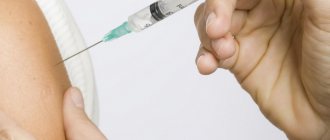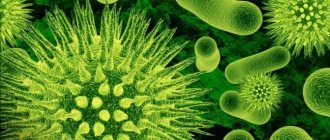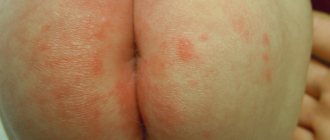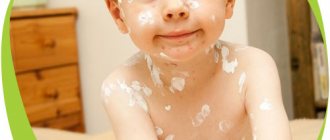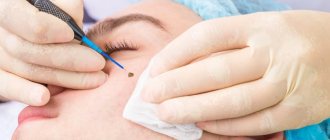Varicella (chickenpox) - symptoms and treatment
How long does chicken pox (chickenpox) last?
The incubation period lasts from 10 to 21 days. In typical cases (in children and adolescents), the disease begins acutely. On average, chickenpox lasts 7-10 days.
Symptoms of chickenpox in adults and children
Chickenpox in adults, due to the loss of lability of the immune system, manifests itself with a subacute and gradual onset (i.e., the main syndrome appears 2-3 or later days from the onset of the disease). Children, as a rule, tolerate the disease more easily.
Symptoms of chickenpox in children and adults:
- general infectious intoxication (SOII);
- vesicular exanthema;
- vesicular enanthema (aphthae);
- lymphadenopathy (LAP);
- persistent fever.
In typical cases, the height of the disease is preceded by a prodromal period lasting up to one day, mild, accompanied by slight weakness, low-grade fever, and rarely a small-spotted rash rash.
By the end of the first day, the height of the disease begins. The first symptoms of chickenpox include increasing intoxication, distinct weakness, and body temperature up to 38-39 ℃. During this period, the most characteristic sign that allows a correct diagnosis to be made is the appearance of a characteristic macular-vesicular rash. The first elements are localized on the scalp and behind the ears, then the rash spreads to the torso and limbs. It is typical that the face is affected later than other parts of the body. Elements of the rash appear in series with an interval of 12-48 hours, each new rash is accompanied by an increase in body temperature, new elements appear between the old ones and their number increases, which causes pronounced polymorphism of the rashes. As soon as the body temperature returns to normal, within 2-3 days we can talk about the healing process and the end of the period of rash.
The dynamics of the rash are very characteristic: first, a rounded reddish spot 5-10 mm in size appears, then a papule forms in the center, then a vesicle (bubble) with transparent contents up to 10 mm (single-chamber and collapsing upon puncture). Further, when secondary flora attaches, it may suppurate, after which it may dry out and form crusts, which fall off after 6-8 days, usually without subsequent defects. In rare cases (severe suppuration, scratching), scars may form.
Simultaneously with rashes on the skin, tender vesicles form on the oral mucosa, which, quickly opening, form aphthae (erosions) and can cause a feeling of discomfort and burning in the mouth.
Chicken pox in newborns
Infants rarely get chickenpox, since most of them are protected by maternal antibodies. If antibodies against the virus are passed on to the child from the mother, then the disease may be erased in a mild form. If there are no protective maternal antibodies, then chickenpox progresses rapidly: symptoms of intoxication are pronounced, convulsions are possible, consciousness is impaired, and complications arise from the internal organs and nervous system.
Chicken pox in pregnant women
Due to the wide spread of the disease, mainly in childhood and adolescence, by the time of pregnancy, women are in most cases immune to the chickenpox virus (i.e., if chickenpox was suffered before pregnancy, there is no risk of recurrence of the disease and no threat to the child; accordingly, there are no risks with contact of a pregnant woman with a patient with chickenpox or herpes zoster). In rare cases, when a pregnant woman does not have a titer of protective antibodies and comes into contact with a sick person, different outcomes are possible, depending on the stage of pregnancy. Acute chickenpox poses a significant danger to the pregnant woman herself (which is often forgotten by both the woman herself and the doctor who diagnosed the disease).
Why does the body itch?
During chickenpox, red spots appear on the body. After a couple of days, the rashes turn into blisters that are very itchy. Inside the inflammation there is an infectious fluid. It comes out after scratching and infects the nearest areas of the epidermis. Gradually, the rash may cover the entire body.
After rupture, the bubble becomes covered with a crust and changes color. Old papules are not sources of infection. But new rashes may appear in this place if the child scratches the red spots and spreads the infection over the skin. For this reason, it is very important to help the baby cope with itching and actively fight secondary infections at home.
Advice from Doctor Komarovsky
The most common question that concerned parents ask their favorite doctor concerns the effects of brilliant green in children with chickenpox. Evgeniy Komarovsky’s answer is unequivocal - there is no therapeutic effect from such an action, brilliant green serves only as an indicator of the period of contagiousness. Lubricating the blisters with a colored solution every day, one day mommy notices that there are no new rashes. From this moment the countdown begins for the last five days, when the baby can pose a danger to others.
The doctor draws the attention of parents to the fact that the viral infection, which is chickenpox in children, is not susceptible to antibiotics and does not require special medications during the normal course of the disease. Only in adolescence, when the disease is too severe, do doctors prescribe antiherpetic drugs.
The main advice that Dr. Komarovsky gives for mothers of sick children:
- avoid overheating, which increases itching;
- cut your nails short, wear gloves if necessary, and do your best to distract the baby from combing the bubbles;
- do not give aspirin so as not to cause liver complications;
- scratching the blisters leads to bacterial infection and the likelihood of marks for life;
- chickenpox quite strongly suppresses the immune system, so after suffering from the disease you should refrain from visiting kindergarten and devote more time to walks.
Regarding vaccinations, Komarovsky believes, sensible parents should not have any discussions. However, he reminds that vaccination against chickenpox is voluntary, so mothers and fathers will have to take responsibility for its implementation.
Antiviral drugs for chickenpox
For chickenpox, medications are prescribed that have antiviral and immunomodulatory effects (Acyclovir, Groprinosin, etc.). Acyclovir is a synthetic drug, produced not only in tablets, but also in the form of an ointment for topical use for chickenpox. Take tablets for 7-12 days, 500-800 mg five times a day, adhering to a 4-hour interval. Apply the ointment to smallpox blisters 5-6 times a day until a crust appears or complete healing.
For patients with reduced absorption in the gastrointestinal tract or severe immunodeficiency, Acyclovir should be administered intravenously.
Groprinosin is active against many viruses, including chickenpox. The tablets are bitter and uncoated, making them a little difficult to swallow.
Take every 6-8 hours up to four times throughout the day, the maximum dose is 6-8 tablets (or 3-4 g) per day. Treatment lasts from five days to two weeks, depending on the clinical symptoms. Groprinosin has many side effects (arrhythmia, renal failure, hypersensitivity, etc.), and is not recommended for use during pregnancy and lactation.
Why is scratching dangerous?
It is unsafe to burst bubbles while scratching; this can cause the child the following consequences:
- Secondary infection. A scratched wound is open to other pathological bacteria and can fester.
- Prolongation of the disease. Chickenpox exudate spreads the herpes virus over the skin, and rashes appear again and again.
- Painful sensations. The blisters cannot heal for a long time; the baby experiences discomfort and pain due to prolonged inflammation on the body.
- Scars on the skin after recovery. If chickenpox papules heal on their own and are not injured, then the skin remains clean after the disease. When scratching, deep scars remain at the site of the wounds that do not go away throughout life.
How long does itching last?
The duration of itching depends on the number of rashes on the body and the intensity of the appearance of new papules. If there are few bubbles, the child will stop itching after 3-5 days. If there are a large number of chickenpox pockmarks and their active renewal, the itching will stop after 7-9 days. Scratching goes away completely when all papules dry out and there are no new foci of infection on the skin.
Important! Treatment for itching should begin after the first pimples appear. How many days the baby will be sick and the severity of the disease depend on how active the parents are in treating chickenpox.
Soothing baths
Many parents are concerned about the question: How to relieve itching with chickenpox in children? In order to eliminate this symptom, it is recommended to use herbal baths to soothe the skin.
Recipes:
- Crushed celandine (50 grams) must be added to boiling water (800 ml). Boil the solution for 5 minutes. The infected person should be bathed using the product received. You need to repeat the procedure in the morning and evening. Effectively helps relieve severe itching.
- Add baking soda (100 grams) to slightly warm water. The patient should bathe in the bath for at least 10 minutes. Repeat therapy every 4-6 hours.
- Mix dried yarrow (150 grams) with 5 liters of boiled water. Leave the solution for 4 hours. The resulting solution must be added to the bath in which the patient must bathe. The duration of the procedure is 20 minutes.
Read also: Acne on the face itches, rashes on the forehead, cheeks: causes and treatment
The above methods will help to quickly and effectively relieve itching from chickenpox in a child. Treatment is necessary until the unpleasant symptom completely disappears.
Chickenpox in infants
It must be remembered that any child over the age of six months can get chickenpox. In most cases, the course of the disease in infants is quite complex: such young children do not tolerate symptoms well, cannot complain and cannot take advice. As a result, they need more careful care and constant attention from the mother.
Chickenpox in newborns is characterized by the same symptoms, but in young children, chickenpox, which occurs in a particularly complex form, can cause serious harm to the body, affecting the development of internal organs. Treatment of chickenpox in infants should be carried out under the strict supervision of a qualified pediatrician.
You should try to ensure that the child does not tear off the scabs from drying out rashes, because This will only make it more itchy and increase the risk of re-infection. The child's hands need to be washed more often, since the causative virus may be present on the skin and under the nails. Nails should be cut short. It is recommended that your baby wear cotton gloves at night.
Folk remedies for chickenpox
During chickenpox, it is very important to boost the patient’s immunity so that the body’s defense system can quickly cope with the disease. To do this, you need to take a mixture of honey and lemon juice. Mix the first and second ingredients in equal quantities, and take a tablespoon orally before meals.
Homemade ointment will help relieve pain and itching throughout the body. Grind 10 g of propolis, mix with fat (glycerin, petroleum jelly, butter). Let the mixture steam for one and a half to two hours. Strain and lubricate the rashes.
This ointment was published for smallpox. Mix equal amounts of rosin and wax, add 1 tablespoon. l. vegetable oil. Melt the mixture over low heat. Spread it on a piece of parchment paper and apply it to the body. Insulate the top with a down scarf. As a result, all boils will remain on the paper, and the body will be clean.
Rashes should be frequently smeared with a water-soda solution. This will have the effect of drying out the blisters and will relieve itching. The patient will not scratch his body and this will protect him from getting a bacterial infection. Stir a teaspoon of baking soda in a cup of warm boiled water and the solution will be ready.
Ointments and creams for topical use for itching from chickenpox
In this section of the article we will answer the question: “How to relieve itching in a child with chickenpox?” Many doctors prescribe ointments or creams for young children with this disease, as they do not cause side effects. The safest ointment for itching with chickenpox is zinc. It helps speed up the healing process of skin rashes, dries them out, relieves irritation and soothes the skin. The drug is applied to the skin several times a day. It can be used both in childhood and in adulthood.



